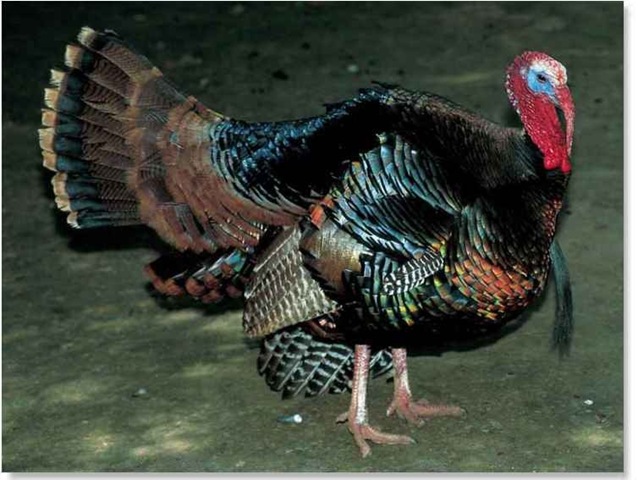ORDER
Galliformes
FAMILY
Meleagrididae
GENUS & SPECIES
key features
• Heavy bird that spends most of its time on the ground, but is a surprisingly powerful flier
• Roosts in trees at night, but the female nests among undergrowth during breeding season
• Courting male displays iridescent plumage and bold skin colors to attract females
where in the world?
Formerly widespread across North America, but now restricted to scattered areas of the united States and parts of northern Mexico
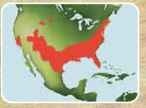
LIFECYCLE
Despite its cumbersome appearance, the wild turkey flies powerfully each evening to its roosting site in the trees. In the morning, it descends again for another day’s foraging.
HABITAT
The wild turkey lives in open woodland and forest with scattered clearings. It needs the trees for nighttime roosting, and open clearings and fields for feeding sites.
The wild turkey prefers oak and pine trees, such as those found in the temperate deciduous forests of the eastern states. The oak and hickory forests of the central states and the subtropical forests of Florida also yield suitable habitats. In the southwestern United States, the wild turkey even roosts on powerlines and windmills and, providing it’s not disturbed, is found in urban areas.
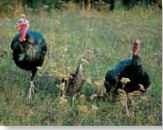
A Living space Seeds and invertebrate prey are found in grassland.
FOOD & FEEDING
The wild turkey eats virtually everything that it can fit in its bill.The young turkey relies on insects during its first eight weeks; invertebrates make up 80% of its diet.The adult eats a range of fruits, seeds, tender shoots, buds, and insects.
In autumn, the turkey eats as much as it can, building up fat reserves for the winter. Large flocks gather and gorge themselves on chestnuts, acorns, pecans, and other nuts. Fallen grain and maize gleaned from fields are another food source at this time of year: Along with its food, the turkey swallows grit. This aids digestion by grinding up tough seeds and nuts in its gizzard (a muscular part of its stomach).
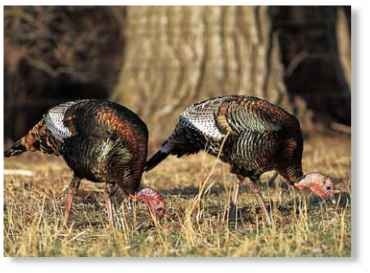
A Grubbing for grubs The wild turkey scrapes the soil to expose insects.
BREEDING
A courting male puts on lavish displays for potential mates. Nesting begins in February in southern states, and in April farther north. The female builds a nest that is a simple scrape in the ground, usually concealed under a bush, or against a tree trunk or log. More than one female may share the nest.
After four weeks, the well-developed, downy chicks hatch and are soon running around the nest area with their mother But as many as half the poults (young) are killed by predators, disease, accidents or cold weather. Those that survive stay with their mother for another eight months or so.
IT’S SHOWTIME!
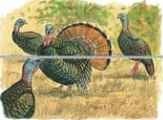
Adoring fans…
To attract a mate in the vicinity, the male drops his wings, fans his tail feathers and struts about, gobbling loudly.
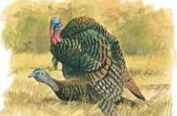
Mating…
The male’s impressive display has won him a partner. Immediately after mating, however, he departs to seek another receptive mate.
The domestic turkey can produce offspring from an unfertilized egg, and it is thought the wild turkey can do the same. Known as parthenogenesis, the process usually results in male chicks.
The wild turkey once came close to being the United States national bird. In fact, Benjamin Franklin preferred the turkey to the carrion-eating bald eagle — the species that eventually won the accolade.
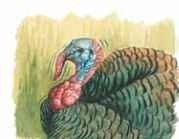
Head-up display…
The male’s head remains upright and quivers slightly, while the folds of skin around its throat puff out and become white in patches.
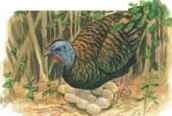
Nesting
The female nests only if she has sufficient fat reserves.She produces a creamy-yellow egg every 25 hours and lays 8-15 in total.
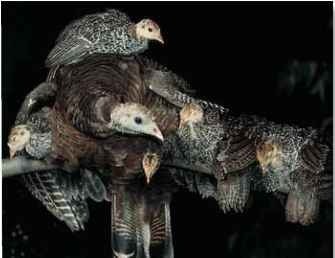
A Family gathering After three weeks, the poults are able to fly with their mother up to a nighttime roosting site in the trees.
CONSERVATION
Overhunting caused wild turkey population to fall from 10 million to 300,000 in the 1940s. Captive-breeding and reintroduction programs have restored numbers to about 1.8 million.
BEHAVIOR
The wild turkey has tiny wings relative to its weight, so a lot of its daily activity is ground-based. If threatened, it runs to safety, flying only as a last resort. Nevertheless, it is a powerful flier and can reach 60 mph in short bursts.
Throughout the summer, females and their offspring form large, noisy brood flocks up to a 100 or so strong, often gathering in meadows and clearings where insect prey is abundant. Within such flocks, the birds participate in ritualized displays and fights to maintain a hierarchy or “pecking order”
Young males leave brood flocks before the breeding season to form bachelor groups, but are unlikely to breed in their first year.
Talking turkey Wild turkeys use nearly 30 different calls.
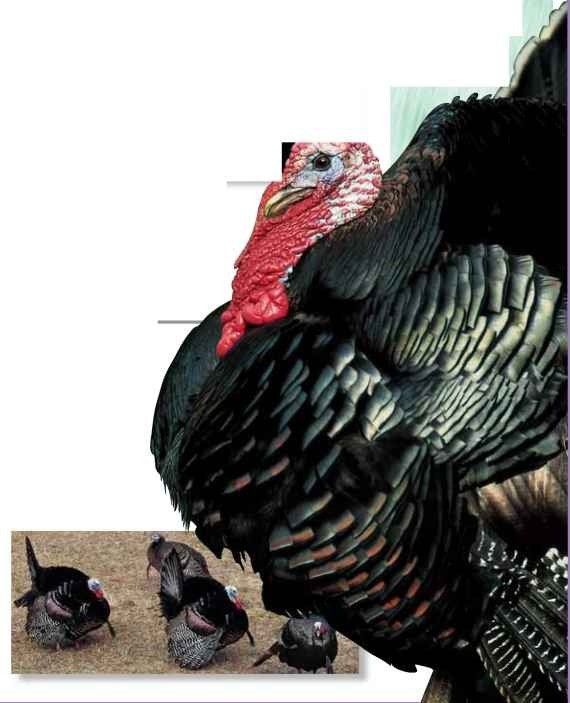
PROFILE
Wild Turkey
The courting male ruffles his splendid body feathers, fans his luxuriant tail and gobbles loudly in an attempt to dazzle his female audience.
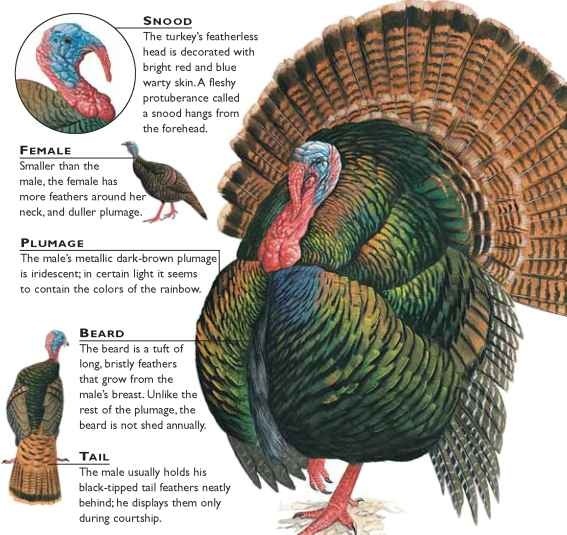
CREATURE COMPARISONS
The brush-turkey (Alectura lathami) belongs to the family Megapodiidae. A ground feeder, like the wild turkey it uses its powerful feet to rake up seeds and insects and to give it a sure grip when roosting in the trees. It’s found in the rainforest, thick scrub and cultivated areas of eastern Australia.
The brush-turkey, about 28″ from head to tail, is smaller than the wild turkey. Its plumage, with shades of black, is less striking than that of its
American cousin.The red-headed brush-turkey lacks a snood, but does have a wattle (folds of skin around the throat), which is bright yellow.
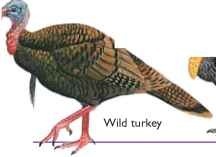
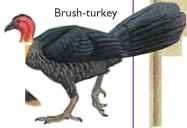
| vital statistics Weight Male 18-22 lbs.; female 10 lbs. |
|
| Length Height | Male 50″; female 36″ Up to 45″ |
| Sexual Maturity | Male 1 year;r ..female 10 months |
| Breeding Season | February-August |
| Number of Eggs | 8-15 |
| Incubation Period | 28 days |
| Fledging Period | 2-3 weeks |
| Breeding Interval | 1 year |
| Typical Diet | Fruits, seeds, vegetation, nuts, grain, maize, acorns, insects |
| Lifespan | 5-7 years |
Related species
• Chickens, turkeys and gamebirds are classed in the order Galliformes. The wild or common turkey and the ocellated turkey, Meleagris ocellata, are the only members of the family Meleagrididae. The ocellated turkey lives in the semiforested lowlands of the Yucatan Peninsula in Mexico, Guatemala and Honduras and has brilliant metallic plumage in rich colors.
